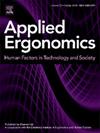24周现场使用背支撑外骨骼对生物力学、工作强度和肌肉骨骼不适的影响:物流工人的随机对照试验
IF 3.4
2区 工程技术
Q2 ENGINEERING, INDUSTRIAL
引用次数: 0
摘要
在为期24周的现场环境中,该试验调查了背部支撑外骨骼(BSE)对后勤工人生物力学、工作强度和肌肉骨骼不适的影响。20名工人被随机分为干预组和对照组,分别在有和没有疯牛病的情况下进行日常拣货。在干预期前后的标准化任务中测量了对肌肉活动和运动学的影响,而在整个干预期对工作强度和肌肉骨骼不适进行了评估。结果表明,在24周前后,在BSE辅助下的举重任务中,背部肌肉活动显著减少。虽然有3名疯牛病患者在干预期间停止使用外骨骼,但其余的工人在24周内逐渐增加了他们的日常疯牛病使用,同时感知工作强度总体下降。该试验表明,疯牛病对背部肌肉活动的影响在24周内保持不变,这与之前基于训练研究的假设相反。本文章由计算机程序翻译,如有差异,请以英文原文为准。
Effects of 24-weeks in-field use of a back-supporting exoskeleton on biomechanics, work intensity and musculoskeletal discomfort: A randomized controlled trial among logistic workers
The trial investigated the impact of a back-supporting exoskeleton (BSE) on biomechanics, work intensity, and musculoskeletal discomfort among logistic-workers over 24-weeks in a field-setting. Twenty workers were randomized into intervention and control groups, performing daily order-picking with and without the BSE, respectively. Effects on muscles activity and kinematics were measured during standardized tasks before and after the intervention period, while work intensity and musculoskeletal discomfort were rated throughout the intervention period. The results indicated significant reductions in back muscle activity during lifting tasks with BSE assistance before and after 24-weeks. Although three BSE users stopped using the exoskeleton during the intervention period, the remaining workers progressively increased their daily BSE use associated with an overall decrease in perceived work intensity throughout the 24-weeks. The trial suggests that the effect of the BSE on back muscle activity remains constant over 24-weeks, opposite what was hypothesized based on previous research on training.
求助全文
通过发布文献求助,成功后即可免费获取论文全文。
去求助
来源期刊

Applied Ergonomics
工程技术-工程:工业
CiteScore
7.50
自引率
9.40%
发文量
248
审稿时长
53 days
期刊介绍:
Applied Ergonomics is aimed at ergonomists and all those interested in applying ergonomics/human factors in the design, planning and management of technical and social systems at work or leisure. Readership is truly international with subscribers in over 50 countries. Professionals for whom Applied Ergonomics is of interest include: ergonomists, designers, industrial engineers, health and safety specialists, systems engineers, design engineers, organizational psychologists, occupational health specialists and human-computer interaction specialists.
 求助内容:
求助内容: 应助结果提醒方式:
应助结果提醒方式:


